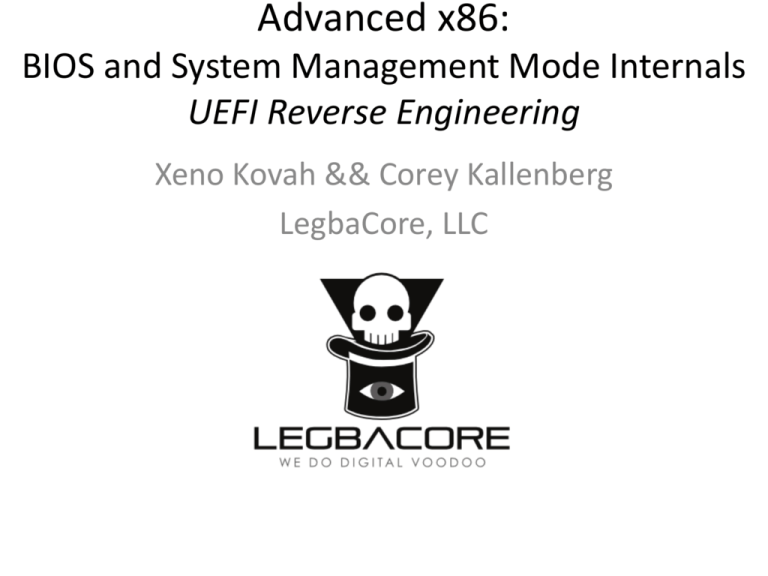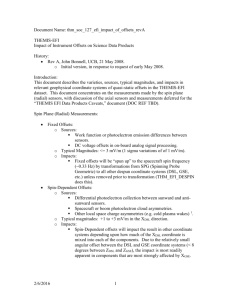IntroBIOS_files/Day2_05_Advanced x86
advertisement

Advanced x86:
BIOS and System Management Mode Internals
UEFI Reverse Engineering
Xeno Kovah && Corey Kallenberg
LegbaCore, LLC
All materials are licensed under a Creative
Commons “Share Alike” license.
http://creativecommons.org/licenses/by-sa/3.0/
Attribution condition: You must indicate that derivative work
"Is derived from John Butterworth & Xeno Kovah’s ’Advanced Intel x86: BIOS and SMM’ class posted at http://opensecuritytraining.info/IntroBIOS.html”
2
And the people yelled:
WE WANT TO ANALYZE
SOME
SOME
CODE!!!1!
CODE!
3
Simmer down y'all.
I reckon what ya best do is…
• Find some subset of interesting code
– You *could* search for B/D/F address of interest
• But better is to narrow down what you want to look at, by
slicing and dicing the firmware filesystem with one of:
• EFIPWN
– https://github.com/G33KatWork/EFIPWN
• UEFITool
– https://github.com/LongSoft/UEFITool
• UEFI Firmware Parser
– https://github.com/theopolis/uefi-firmware-parser
– We're not going to cover this for now, since I haven't built it on
Windows yet
4
Firmware Storage
SPI Flash
Flash Descriptor
Gigabit Ethernet
Platform Data
Management Engine
Firmware Device refers to the flash chip
UEFI/BIOS
• UEFI utilizes the physical flash device as a storage repository
• Comprised of 4 basic components:
–
–
–
–
Firmware
Firmware
Firmware
Firmware
Device
Volume
File System
Files
5
Firmware Volumes (FVs)
SPI Flash
Flash Descriptor
Firmware Volume(s)
FV0
Gigabit Ethernet
Platform Data
Management Engine
FV1
FV does not
have to align
with the start
of the BIOS
region as
configured in
the Flash
Descriptor
UEFI/BIOS
• A Firmware Device is a physical component such as a flash chip.
• We mostly care about Firmware Volumes (FVs)
• We often see separate volumes for PEI vs. DXE code
– And occasional “duplicate” volumes for restore-from-backup
• FVs can contain multiple firmware volumes (nesting)
• FVs are organized into a Firmware File System (FFS)
• The base unit of a FFS is a file
6
Firmware File System (FFS)
FV0
FV1
FFS
•
•
•
•
FVs are organized into a Firmware File System (FFS)
A FFS describes the organization of files within the FV
The base unit of a FFS is a file
Files can be further subdivided into sections
7
Firmware Files
• We mostly care about file sections that are in PE (Portable
Executable) file format
– Alternatively can be a TE (Terse Executable) which is a “minimalist” PE
Oh, how interesting! My BIOS uses "Windows" executables? I know how to analyze those!
Yay Standardization!
A standard way of putting together
the firmware filesystem, with nice
human readable names, makes it
easier for me to find my way around
to the likely locations I want to attack
A standard way of putting together
the firmware filesystem, with nice
human readable names, makes it
easier for me to understand the
context of what might have been
attacked if I see a difference there
UEFITool/UEFIExtract
• The best and most up-to-date firmware
filesystem parser
10
Go to File->Open and select the file dump (I selected the "e6430A03.bin")
Navigation by expanding
portions here
Parsed metadata here
Here it's interpreting the
Flash Descriptor and
telling us which regions
the BIOS can access
11
This volume holds a bunch of PEIMs (and the one above it a bunch of DXE drivers.)
"AmgTcgPlatformPeiBeforeMem" is the PEIM we're going to be interested in shortly
To get a well-formed PE file, we extract it by right clicking and selecting "Extract body"
UEFIExtract is a simple command line tool that just dumps everything
out to the filesystem instead of making it navigable from a GUI
The metadata will be stored off to the side in
.txt files
14
This is good if you want to search all the files for a pattern. But it's less
easy to navigate if you want to just get a single file (in that case just use
the GUI)
15
Identifying Changes in BIOS (bios_diff.py)
• So as we know, Copernicus provides us the full dump of the
BIOS flash
– Repeated from previous: Copernicus maintains the FLA offsets for each
region by reading even those which the CPU/BIOS master has no
permissions to read (like the Management Engine, typically)
– Any BIOS dump should work as long as it’s a UEFI BIOS (structured for
better parsing)
• Comparing BIOS dumps over a period of time can provide
change detection
• How this differs from observing the TPM PCR registers is this:
• When a PCR tells you a change has been made, it cannot tell
you where the change has been made
• Bios_diff.py uses the decomposition capability of EFIPWN to
tell us the particular module(s) in which the change(s) is/are
located
16
Identifying Changes in BIOS (bios_diff.py)
• This script uses EFIPWN to parse and diff the modules
between two BIOS dumps
• EFIPWN decomposes the BIOS into its firmware volumes
(FVs) and then decomposes each into the files/modules that
comprise it
• In this example we’re analyzing an earlier “known-good” BIOS
with one which we notice has changed
– We took a known good and purposefully made a small change in the
“suspicious” one
17
Identifying Changes in BIOS (bios_diff.py)
• The script has found a difference located in firmware volume
3
• Some files/modules have user-friendly names and if this is the
case the script outputs this name
• AmiTcgPlatformPeiBeforeMem
• Tcg could be Trusted Computing Group and this is likely a
PEIM that executes before memory is established
18
Identifying Changes in BIOS (bios_diff.py)
• If more than 1 diff is found they will all be listed here in this
manner
• In this case it is just a single diff found
• Diff was found at offset 0x40C in the file
“AmiTcgPlatformPeiBeforeMem”
• The length of the diff is 7 bytes
19
Identifying Changes in BIOS (bios_diff.py)
• Files in the UEFI Flash File System are in the PE format (or
TE [Terse Executable], which is a minimalist PE file)
– But still PE
• For this reason we can identify whether diffs are located in the
.data or .text (code) sections of a given file
– In this case the change occurs in the code section
20
Identifying Changes in BIOS (bios_diff.py)
• Also from the PE file we can get the Virtual Address of the
change in the file
• From this we can derive both the Flash Linear Address of the
change on the serial flash (provided the size of the BIOS
region) and therefore its location in mapped high-memory
• The output also identifies the Relative-Virtual Address (RVA),
which is the segment offset from the start of the PE file
21
Identifying Changes in BIOS (bios_diff.py)
• We can use the VA and RVA information to locate this PE file
in the BIOS hex dump
• VA – RVA = beginning of PE file
• But first let’s convert that VA to a flash linear address:
• FFFF_FFFFh – FFE6_D090h = 19_2F6Fh
• <.bin size> - 19_2F6Fh = BF_FFFFh - 19_2F6Fh = A6_D090h
• A6_D090h – 40C = A6_CC84h
22
Analyzing UEFI Files with IDA
(Search for “MITRE Copernicus Analyzing
BIOS Differences with IDA Pro”)
23
Analyzing UEFI Files
• Following our example of finding a “diff” across multiple BIOS,
let’s find out how to analyze the change using IDA
• This should strike a sharp contrast to trying to analyze a
legacy BIOS which does not follow public standards
– Not to say they don’t have internal standards, just that those standards
are not public
• The free version of IDA will be adequate for these purposes
24
• The first step having identified a change between two BIOS
dumps is to first locate the specific files in which the
change(s) were detected
• In our example, the changes occur in Firmware Volume 3
• Find the directory where EFIPWN decomposed the UEFI
binary and go to firmwareVolume3
25
Analyzing UEFI Files
• Inside the firmwareVolume3 directory is a directory listing of GUIDS
• Find the GUID in which this diff was detected
• In this case it is GUID:
– e9312938-e56b-4614-a252-cf7d2f377e26
• Inside this directory you will find the PE32_94 file which contains the
file that has changed
• You can locate both of these files in this manner: the previous one
which is assumed to be good, and the new one in which the change
has been observed
26
Quick look in hex editor
• One of the first things you can do upon acquiring both files is
to observe them in a hex editor
• HxD allows you to easily perform binary comparisons
between 2 files (Analysis > File-Compare > Compare, and
then select the 2 files you want to compare)
27
Quick look in hex editor
• HxD’s file comparison compares each file in parallel and highlights
each byte that differs
• It’s a quick way to “eyeball” changes which have been detected
• This is less helpful when the file-sizes differ and the area where you
want to analyze the change occurs at an offset other than where it
usually does
28
Quick look in hex editor
• In this simple example, the “haxed” version of the PE file has
opcode 0xC3 at offset 0x40C while the original file has 0x8B
• Those who are familiar with the x86 instruction set may recognize
the 0xC3 opcode as the RET (return) instruction
• Note that at the bottom of the HxD window it shows the file offset of
the highlighted diff byte (“Block 40C-40C”)
• This corresponds to the information outputted by our bios_diff.py
29
Quick look in hex editor
• You can cycle through each byte that is different by pressing
‘F6’ (Next Difference)
• In this simple example, there is only this single byte that is
different
30
Analyzing UEFI Files with IDA
•
Now we’ll actually take a look at these files in IDA
–
•
Notice IDA recognizes the PE file format and opens the file accordingly
–
•
Free version is mostly adequate, minus the Hex-Rays pseudo-code view
IDA 6.7 will recognize UEFI files! (but can’t distinguish between PEI and DXE drivers, and so just
applies a DXE entry point definition in both cases)
Shown here is the non-hacked version of the TPM driver showing real instructions at the
entry point
31
Analyzing UEFI Files with IDA
• Shown above is the hacked file with just the RET at the entry
point
• This simple example assumes the attacker has placed this
instruction here so that the TPM driver never performs any of
its activities
32
Analyzing UEFI Files with IDA
• To see the pseudo-code you will need the full version of IDA
Pro with Hex-Rays
• The non-hacked file is dereferencing a DWORD at offset 24 of
arg 2
– IDA displays offsets in base 10 by default; 24 is 0x18
• The dereference is followed by a call: (a2, &unk_FFE6D744)
• So this appears to be calling a function pointer from out of a
table
33
Applying UEFI Structure Definitions
• UEFI uses publically-defined data structures
• We’re going to import ‘behemoth.h’ which was created by Snare
(using scripts)
– https://github.com/snarez/ida-efiutils/blob/master/behemoth.h
– Snare has done a talk on attacking Apple’s EFI implementation
– Black Hat USA 2012:
http://ho.ax/downloads/De_Mysteriis_Dom_Jobsivs_Black_Hat_Slides.pdf
– White Paper: http://ho.ax/De_Mysteriis_Dom_Jobsivs_Black_Hat_Paper.pdf
34
Applying UEFI Structure Definitions
• Our behemoth.h file is located in the C:\Tools\ directory
• It contains a lot of structure definitions from the EFI
Specification
– Plus enumerated values and types
35
Applying UEFI Structure Definitions
• Ignore any errors you see when importing this file
– Importing the structures we use will still work
36
Applying UEFI Structure Definitions
• Now go to the Structures tab
• Hit ‘Insert’
37
Applying UEFI Structure Definitions
• Select ‘Add a Standard Structure’
38
• We can sort the
structures by name to
make search easier
• We’re looking for
EFI_PEI_SERVICES
• These are services
used by PEIMs during
the PEI phase
• An (incomplete)
sampling is below:
39
Applying UEFI Structure Definitions
• Now we’re going to add an EFI_GUID structure
40
• A GUID is a 16-byte
data structure used as
a name for many of the
EFI objects:
–
–
–
–
Dword
Word
Word
Char array[8]
41
Applying UEFI Structure Definitions
• Likely this file will be using the PEI Services table:
• The name of the file is ‘AmiTcgPlatformPeiBeforeMem’
• It’s a common structure used during the PEI phase so PEIMs
can use common services
42
Applying UEFI Structure Definitions
• Hit ‘t’ to have IDA interpret that value as a structure
• Select EFI_PEI_SERVICES based on our hypothesis
43
Applying UEFI Structure Definitions
• Hit Ok or ‘y’ to accept this definition
• IDA does not have an undo, so it’s always good to save first
– But we have a hunch that this is the right object
44
Applying UEFI Structure Definitions
•
•
•
•
In the pseudo-code view you can do the same thing
Select the a2 argument and hit ‘t’
Select the EFI_PEI_SERVICES structure
When we enter the above, we see the code simplifies:
45
Applying UEFI Structure Definitions
• We see that this function immediately calls the InstallPpi() PEI
Service
• InstallPpi() takes 2 arguments:
– The EFI_PEI_SERVICES structure
– Some Unknown argument
• Per the EFI Specification, InstallPpi installs an interface in the
PEI PEIM-to-PEIM Interface (PPI) database by GUID
• We could look up the prototype in the spec:
46
Always let the GUIDs be your GUIDe
• UEFI uses a lot of “GUIDs” – Globally Unique
IDentifiers.
• Used to identify files on the filesystem
– Filesystem GUIDs often reused between EDK &
production systems. Or between the same IBV
code on different OEMs’ systems
• Used to identify structures (PPIs in PEI phase,
Protocols in DXE phase) that contain data
and/or function pointers
47
48
Tracing PPIs
• But in this case IDA also recognizes this structure
• We can double-click on it to see that IDA has identified it as
an EFI_PEI_PPI_DESCRIPTOR :
– First is the Flags 80000010h
– Second is the pointer to the GUID
– Third is the pointer to the PPI that will be installed
49
Tracing PPIs
• Select the GUID structure
• One thing we can do is try and determine if this is a knownGUID or an unknown GUID
– The UDK defines a lot of GUIDS, these would likely be the same across
all vendors
– Vendors also implement their own proprietary GUIDS
50
Tracing PPIs
• Snare also provides the efiguids.py file which contains GUIDs he
pulled out of the UDK
• Our efiguids.py is located in C:\Tools\ and contains previously
identified GUIDs
• In this case it is not in this file. We can name it ‘UnknownGuid1’
51
Tracing PPIs
• Now if we follow the pointer it will take us to the PPI that is
going to be installed
• This function is what will get called when someone uses this
PPI
52
Recurse & define
• We can analyze this is pseudo-code or the main view
• Since it accepts one argument we can hypothesize again that
it takes in an instance of the EFI_PEI_SERVICES structure
53
Recurse & define
• As before, we can define this as EFI_PEI_SERVICES**a1
54
Recurse & define
• Also we can define v1 in the same way since its equal to a1
• EFI_PEI_SERVICES**v1
55
Recurse & define
• Now we can scroll down and see that we were right in
assuming this was an instance of a EFI_PEI_SERVICES
• We see a call to LocatePpi(), and then GetBootMode(),
followed by InstallPpi()
• This series of EFI services “makes sense”
56
Recurse & define
• We can look up the definitions for the new services
LocatePpi(), GetBootMode()
• Can we identify the GUID located in the
EFI_PEI_PPI_DESCRIPTOR passed into InstallPpi?
57
Analyzing UEFI Files with IDA
• So from here the strategy would be to use the same
methodology to identify and “fill out” LocatePpi(),
GetBootMode(), etc.
• For you, cross-correlating where the PPIs are defined that you
see getting called later will take a bit of grunt work (grepping
for guids, finding their usage, etc)…
• For us, it’s already scripted ;)
58
Further GUID-based analysis strategies
• If you binary grep for a GUID (or search by GUID
in UEFITool), you may find that it is specifically
referenced/loaded by some other file.
• Pick a GUID in the spec that you’re interested in.
E.g. EFI_DHCP4_PROTOCOL_GUID
• If you grep for it, you’ll find everywhere that
particular protocol/PPI is used (to include
installation, lookup, and things that have
registered to be notified when it’s available)
– Then you just have to sift through the results
59
TODO:
• Add discussion of diffing things against EDK &
against other known stuff
• Here comes a new challenger!
• http://joxeankoret.com/blog/2015/03/13/dia
phora-a-program-diffing-plugin-for-ida-pro/
60
UEFI/Secure Boot Summary
• Secure boot can help you protect your firmware
– If your BIOS is UEFI but Secure Boot isn’t used, you can self-sign keys
and turn it on
• But if the SPI flash isn’t locked down, secure boot doesn’t
provide any protection
– And neither does System Management Mode, or signed firmware
updates, or TPM Measured Boot…
• UEFI does add complexity to locking down the SPI flash SPI
Protected Range (PR) registers can be used to lock down the
UEFI executable firmware
• But the NVRAM variables must remain writeable
61
A Locked Down UEFI/BIOS Does the Following:
• Has a properly-configured flash descriptor
– Read-only, provides proper Flash Master permissions
•
•
•
•
•
•
•
•
•
•
Protects the UEFI executable code using the PR registers
Locks down the SPI flash configuration registers (FLOCKDN)
Uses BIOS_CNTL to protect the flash
Implements signed firmware updates
Implements Secure Boot
Ensures SMM_BWP is asserted so that the flash is writeable
only when the processor is in SMM
Ensures SMRAM is locked down (D_LCK is set and SMRR are
used)
Ensures SMI’s are enabled and cannot be suppressed
If possible uses Measured Boot and observes PCRs
Sounds simple enough…
62
• Oh but vendors also need to ensure that none of the code
they implement in SMRAM is buggy
• On the Dell Latitude E6430, ~144 out of 495 EFI modules
appear to contribute code to SMM …
63
Backup
• Used EFIPWN to backup because we don’t
recommend its use as a primary tool anymore
(but it is still used behind the scenes for
Copernicus’ bios_diff.py)
64
EFIPWN
https://github.com/G33KatWork/EFIPWN
65
Setting up EFIPWN
• This describes using a version of EFIPWN modified by Sam
Cornwell who added some improvements:
•
•
•
•
•
•
EFIPWN requires the following:
Python (I use 2.7.x-something)
Mako: http://www.makotemplates.org/
ArgParse: https://pypi.python.org/pypi/argparse
Pylzma: http://www.joachim-bauch.de/projects/pylzma/
I have an easier time downloading the source and installing
using “python setup.py install”
• You will also need the ‘xz’ utility
– Mac and Linux: you get it either automatically or by easy download
– Windows: http://tukaani.org/xz/
– The pre-built binaries work fine. I tested it by putting the bin_x86-x64
version into the local EFIPWN directory and it worked fine
66
Testing EFIPWN Functionality
• Once you have all the dependencies installed, typing the following
‘python dump.py –h’ should yield the above output
• The arguments are a little confusing for EFIPWN, as a general rule
they go like this:
• Python dump.y <file> <print, dump> <output>
• * The genfdf function does not work yet
67
EFIPWN ‘print’
Specify ‘print’ to gather information
about the structure of the UEFI
binary
Redirect this output
to a text file
• Before we decompose a UEFI binary, we’ll use the ‘print’
functionality to print a text file containing the UEFI firmware
volume information and the PE files/modules contained
therein
68
EFIPWN ‘print’: Firmware Volume
• The base offset is the Flash
Linear Address (FLA) in the
file where the volume
begins
• This page shows one FV
beginning at 60_0000h and
another immediately
following it at 62_0000h
69
EFIPWN ‘print’: Firmware Volume
• The Header length refers to the length in bytes of the FV
header
• The Data length refers to the length in bytes of the FV minus
the header
• The Total length refers to the total length of the FV including the
header
70
EFIPWN ‘print’: Firmware Volume
• The Signature of a firmware volume is {‘_’, ‘F’, ‘V’, ‘H’}
• The signature field only applies to Firmware Volumes
71
EFIPWN ‘print’: Firmware Volume
• The attributes field declares capabilities and power-on defaults
for the firmware volume
72
EFIPWN ‘print’: Firmware Volume
// Attributes bit definitions
#define EFI_FVB2_READ_DISABLED_CAP 0x00000001
#define EFI_FVB2_READ_ENABLED_CAP 0x00000002
#define EFI_FVB2_READ_STATUS 0x00000004
#define EFI_FVB2_WRITE_DISABLED_CAP 0x00000008
#define EFI_FVB2_WRITE_ENABLED_CAP 0x00000010
#define EFI_FVB2_WRITE_STATUS 0x00000020
#define EFI_FVB2_LOCK_CAP 0x00000040
#define EFI_FVB2_LOCK_STATUS 0x00000080
#define EFI_FVB2_STICKY_WRITE 0x00000200
#define EFI_FVB2_MEMORY_MAPPED 0x00000400
#define EFI_FVB2_ERASE_POLARITY 0x00000800
#define EFI_FVB2_READ_LOCK_CAP 0x00001000
#define EFI_FVB2_READ_LOCK_STATUS 0x00002000
#define EFI_FVB2_WRITE_LOCK_CAP 0x00004000
#define EFI_FVB2_WRITE_LOCK_STATUS 0x00008000
#define EFI_FVB2_ALIGNMENT 0x001F0000
#define EFI_FVB2_WEAK_ALIGNMENT 0x80000000
#define EFI_FVB2_ALIGNMENT_1 0x00000000
#define EFI_FVB2_ALIGNMENT_2 0x00010000
#define EFI_FVB2_ALIGNMENT_4 0x00020000
#define EFI_FVB2_ALIGNMENT_8 0x00030000
#define EFI_FVB2_ALIGNMENT_16 0x00040000
#define EFI_FVB2_ALIGNMENT_32 0x00050000
#define EFI_FVB2_ALIGNMENT_64 0x00060000
#define EFI_FVB2_ALIGNMENT_128 0x00070000
#define EFI_FVB2_ALIGNMENT_256 0x00080000
#define EFI_FVB2_ALIGNMENT_512 0x00090000
#define EFI_FVB2_ALIGNMENT_1K 0x000A0000
#define EFI_FVB2_ALIGNMENT_2K 0x000B0000
#define EFI_FVB2_ALIGNMENT_4K 0x000C0000
#define EFI_FVB2_ALIGNMENT_8K 0x000D0000
#define EFI_FVB2_ALIGNMENT_16K 0x000E0000
#define EFI_FVB2_ALIGNMENT_32K 0x000F0000
#define EFI_FVB2_ALIGNMENT_64K 0x00100000
#define EFI_FVB2_ALIGNMENT_128K 0x00110000
#define EFI_FVB2_ALIGNMENT_256K 0x00120000
#define EFI_FVB2_ALIGNMENT_512K 0x00130000
#define EFI_FVB2_ALIGNMENT_1M 0x00140000
#define EFI_FVB2_ALIGNMENT_2M 0x00150000
#define EFI_FVB2_ALIGNMENT_4M 0x00160000
#define EFI_FVB2_ALIGNMENT_8M 0x00170000
#define EFI_FVB2_ALIGNMENT_16M 0x00180000
#define EFI_FVB2_ALIGNMENT_32M 0x00190000
#define EFI_FVB2_ALIGNMENT_64M 0x001A0000
#define EFI_FVB2_ALIGNMENT_128M 0x001B0000
#define EFI_FVB2_ALIGNMENT_256M 0x001C0000
#define EFI_FVB2_ALIGNMENT_512M 0x001D0000
#define EFI_FVB2_ALIGNMENT_1G 0x001E0000
#define EFI_FVB2_ALIGNMENT_2G 0x001F0000
• Defined in Vol. 3 Shared
Architectural Elements
73
EFIPWN ‘print’: Firmware Files
• Firmware files are code and/or data stored within firmware
volumes
• Combined, Firmware Files are described/contained within a
Firmware File System
• Base offset refers to its relative location within the volume
• Length refers to the length of the file
• GUID is its ID
74
EFIPWN ‘print’: Firmware File
...
• There are different enumerated types of Firmware Files
• Defined in Vol3 Shared Architectural Elements Section 2.1.4.1
75
EFIPWN ‘print’: Firmware Files
• Firmware Files have attributes like Firmware Volumes do (and
are the same)
• The State of the file is intended to preserve integrity
76
EFIPWN ‘print’: Firmware Files
Bits 6, 7 are reserved bits.
• You can see that it includes the provision for marking files as
deleted, which is kind of interesting. But unlike filesystem
forensics, all these tools should basically show you all files,
whether they’re deleted or not
77







